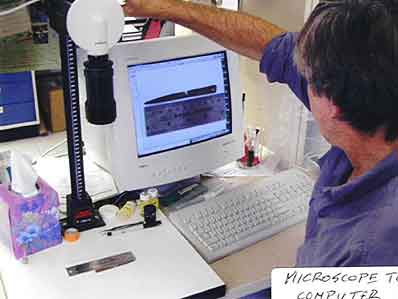|
In 1989, the remains of a human
skeleton were discovered in a rock shelter at the Cook petroglyph
site in Wyoming County, West Virginia during an archaeological
Phase II investigation. Upon examination, archaeologist Robert Pyle
speculated a connection between the ancient
human remains and the Ogam petroglyphs about ten meters away.
This discovery would become
the highlight of nineteen years of ongoing research on Ogam petroglyphs
which was heralded by the March 1983 Wonderful West Virginia magazine.
Photographs and stories in that issue connected southern West Virginia's
mysterious petroglyphs—with
their Christian message—to the legendary transatlantic voyages
of St. Brendan of Ireland in the sixth century AD.
One of the arguments against
this hypothesis has been that there was no physical scientific proof.
So this discovery was believed to be significant. The Skull, that
of an adult male, was sufficiently preserved to recognize a unique
brachycephalic (round headed) feature indicating a possible European
origin. Based on the archaeologist's experience, the condition of
the remains indicated great age.
 |
Dr. Thomas WE. Stafford Jr., Boulder,
Co. examines markings
on a bone needle found near the burial site. |
But the only proof would come
from future DNA and radiocarbon testing to determine the ethnicity
and age of the remains, so the remains were carefully preserved
for future analysis. Not until the year 2000 was funding made available
from a private source to pay for DNA analysis and radiocarbon dating.
Mitochondrial DNA was extracted
from the roots of the teeth and compared to previously cataloged
DNA sequences from ethnic groups around the world. No association
was found among North American groups. The closest DNA matches were
European.
Radiocarbon dating (commonly
called C14) established the age of the remains at 1,292 +/-40 years
old (about the year 710 +/- 40 years AD).
These combined scientific data
from DNA and C14 testing establish the presence of a person of European
origin in southern West Virginia around the year 710 AD, the earliest
date that a European has been positively identified on the North
American continent through scientific data. There have been numerous
theories and extensive controversy for the past two centuries about
pre-Columbian visitors to this continent, but no suitable remains
have been discovered and available for testing with any conclusive
results until now.
Additional research and analysis
are ongoing in this project. Further laboratory testing is contingent
upon the availability of funds. Qualified researchers interested
in contributing to this project are encouraged to contact the author.
Robert
L. Pyle, Archaeologist
Resume and Qualifications
To learn more about the mysterious petroglyphs found
in West Virginia and Kentucky and their connection to Europe, visit
our Petroglyph People page.
Comprehensive information about
the petroglyph studies appears in Robert L. Pyle's book "All
That Remains: A West Virginia archaeologist's discoveries, 2nd edition."
It can be ordered for $25 total (includes shipping) from Robert
L. Pyle, 1964B Negley Avenue, Morgantown, W.Va. 26505. www.AncientRemains.com
|
We
Need Your Help!
Our work has just begun and funding is needed for preservation,
historical research, museum exhibits, and preparation of educational
documentaries.
Donations
can be sent to:
WV Petroglyph Trust
I964 B Negley Avenue Morgantown, WV 26505
|
|

